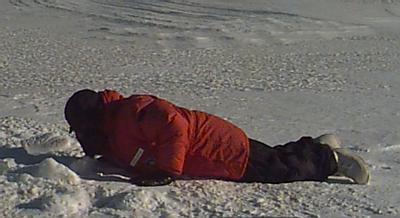
|
|
14 October, 1996
Today started with spryte training. We use our spryte to transport the
divers over the sea ice to dive sites. Since any us could be going to a site
as either a diver or tender, we're all expected to be able to drive a
tracked vehicle. Driving is not difficult, but knowing where it's save to
drive is. Even though the ice in McMurdo Sound is five feet thick, it
contains numerous long cracks. One way to spot cracks is to look for seals
lying on the ice. To get to the surface they make holes in the cracks. I've
included a picture of Gamini looking down a seal hole. As he bent over the
hole, a seal stuck its head out. I don't know who was more surprised, Gamini
or the seal.
To determine if a crack is safe to cross, holes are drilled with a hand
augers. If the ice is less than about two feet thick, the spryte has to find
a way around the crack. This could add miles to a trip and consume valuable
research time. Several days ago a vehicle rolled over as it went over a
crack. The location of the crack was well known and it had been crossed a
number of times in the past. It makes me realize how dynamic the ice is.
The next project for the day was to help Jim with bioassays. One of the
groupís research functions is to determine if the gametes released by
primitive organisms contain chemicals that protect them from predation. The
gametes or sperm and egg cells, which are released during spawning, will
move up in the water column. As they develop into a larval stage they move
back to the bottom that is often littered with anemones and sea stars, both
veracious predators. Are they able to survive because of chemical defenses?
If larvae that are chemically defended are identified, and the chemicals
collected and identified, other scientist could determine if they have
properties useful to us.
Several days ago the divers collected tunicates that were dissected to
remove the gonads. They also collected a number of sea stars and anemones.
Jim feed bits of the gonads to both the sea stars and anemones and recorded
if they were accepted or rejected. If they were accepted he timed how long
it took before the food bits were consumed. As a control, the animals were
also offered pieces of krill. If the statistical analysis of the assay shows
the gonad bits are rejected more than the control, the chemists in the group
will begin isolating the responsible chemicals.

Contact the TEA in the field at
.
If you cannot connect through your browser, copy the
TEA's e-mail address in the "To:" line of
your favorite e-mail package.
|
